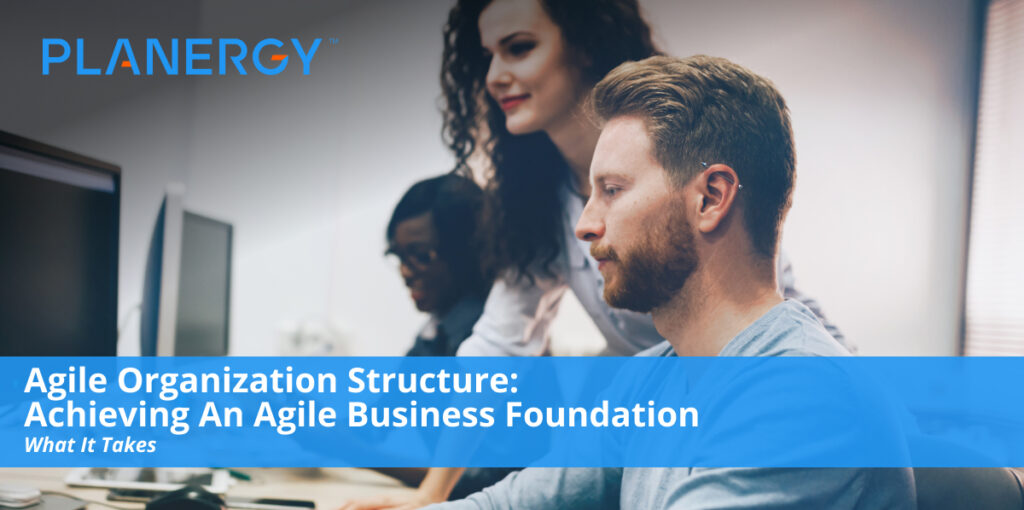An agile organization is one that is able to adapt and react quickly to an ever-changing environment. They embrace an unpredictable and complex environment.
They are customer-centric instead of focused on profits. For an organization to be truly agile, it must build a fast learning and decision cycle, create a network of teams that are empowered and individuals who are enabled by technology. Together, they all must be driven by a shared purpose.
In the past, organizations were treated as if they were machines. Clear how in 1910, Ford Motor Company was a small automobile manufacturer. Just 10 years later, Ford held 60% of the market share of the new automobile market globally.
Ford reduced assembly time per vehicle from 12 hours to just an hour and a half with the price from $850 to $300 while also paying employees competitive wages.
For decades, organizations that use this machine model were able to dominate their markets.There were disruptive Trends with the introduction of the digital Revolution that started to transform economies, societies comment Industries.
The quickly involving evolving environment, the constant introduction of disruptive technology, and accelerating digitization along with the new war for talent begin to erode the machine approach to organizational structure.
Agile organizations are not machines but should instead be treated as if they were living organisms. As our circumstances change, we grow, evolve, and adapt.
Our needs change, which means to survive and thrive, we have to be willing to make changes necessary to support us to become the best versions of ourselves possible. An agile organization is no different.
Organizational agility is neither top-down nor bottom-up. Instead, it is “in” because the focus is on delivering value to customers based on customer needs. Your customers are not your managers.
Where traditional organizations rely on a manager or team of managers who determine what needs to be done and then make sure the employees complete the work according to the instructions, agility means having a team of self-managing employees who know what needs to be done and get it done on their own.
For companies who have a fundamental belief in the manager is the boss approach, it is difficult to adopt agility effectively. There is continuing friction between the approaches and goals. As a result, the adoption of agile being dysfunctional and incomplete and thereby provides little if any benefit to the company.
Building an agile company aims to address volatility, uncertainty, complexity, and ambiguity. Otherwise known as VUCA, this describes the constant, unpredictable chance that most industries are now dealing with as part of the norm.
Following the VUCA approach demands agility because it requires you to steer clear of the traditional, outdated approaches to leadership and management, as well as day-to-day working.
Switching to an agile organization approach allows you to adjust your team structure so that you avoid silos and foster adaptability, while everyone grows their skill sets.
Stakeholders can and should still be in a hierarchical structure that we are familiar with. It’s the rest of the company that should focus on building agility, regardless of the methodology used to achieve it.
A Closer Look at VUCA
Volatility
This is a challenge that’s unstable, unexpected, and you may not know how long it will last. It’s not necessarily difficult to understand since knowledge about it is generally available.
An example is that you may see prices fluctuate after one of your suppliers is unable to provide a product or service after a natural disaster.
To address this, you’d build in a bit of a buffer and devote some resources to being prepared. For example, you could stockpile inventory or overbuy talent. Because these actions are generally expensive, you should make sure your investment matches your risk.
Uncertainty
In this situation, other information may not be available, but the event’s basic cause and effect are known. You know that change is possible, but not guaranteed.
For instance, your competitor has a pending product launch. Until you see its outcome, the future of the business and market are a bit muddy.
To address this, invest in information. Collect it, interpret it, and share it. This approach gives the best results when it is combined with structural changes, such as adding information analysis networks to reduce ongoing uncertainty.
Complexity
These situations have many parts and variables that are interconnected. Some may even be dependencies. There is a bit of information available, or some of it can be predicted. But, it’s the volume or nature of the information that can be difficult and overwhelming to process.
As an example, let’s say you’re conducting business in many countries. All of them have different cultural values, regulatory compliance requirements, and tariffs you have to deal with.
To address this, you can restructure your organization. Alternatively, you can develop or hire specialists, which then allows you to build up the necessary resources you need to address the complexity. For instance, you could hire consultants to help you address the cultural issues, accounting experts to help you deal with the tariffs, etc.
Ambiguity
With these situations, you’re looking at “unknown unknowns.” There is no precedent to base anything on – you’re basically in a completely unclear casual relationship.
For example, you decide to move into an emerging or immature market, or make the choice to launch a product outisde of your core competency.
The only approach you really have here is to experiment. Before you can understand cause and effect, you must first build and test hypotheses. The key is to design experiments that allow you to learn lessons you can apply broadly.
Ambiguity and Uncertainty are guides to help you understand how much you know about the situation. Complexity and uncertainty can help you gauge how well you can predict the results of your actions.
What Does an Agile Organization Look Like?
Shared Purpose
Organizations work to build a culture that focuses on their people by investing in their development.
This builds a strong community of empowered employees. A people-centric and inspired leadership organizational culture is key to connecting vision and purpose to employees.
Customer-Centered
On optimizing the operational processes to increase overall profit margins, as agile organizations focus on understanding their customers’ needs and building customized solutions.
That doesn’t mean making a profit is less important to an agile organization. These companies increase their profits through value creation for their customers.
A Network of Teams
Agile organizations generally maintain a traditional top-level hierarchical structure, but the remainder of the company is built to be a system of autonomous network of teams with a shared purpose and vision.
Each team will have its own project management and deliverables, and many of the projects may be dependent on others within the company, in other business units.
That’s why it’s important to build the network of teams – to avoid silos and keep everyone apprised of what’s going on.
Open Communication
Agile organizations must build a transparent and open style of communication. This makes it easier for individuals and teams to get the information they need to make good decisions.
It also allows these decisions to be made much faster than they would be in a system that enforces a specific communication structure defined by policies and protocols for every situation. This open communication and transparency will help build more employee engagement.
Quick-Moving Learning and Decision Cycles
Early response to an unpredictable and ever-changing environment quickly, all agile organizations rely on short learning, product development, and decision Cycles.
By making continuous small and focus changes, they will incrementally add value. Slow decision-making can eat away at any competitive advantage your organization may have.
Integration of Technology
Instead of simply digitizing all existing processes, agile organizations truly integrate new technology into operational processes. New collaboration, communication, budgeting, and management tools, for instance, don’t only introduce a new way of working together and managing projects but also aim to save a lot of time.
Implementing agile ways into your processes isn’t something that will happen quickly. Taking time to get there is what matters.
How to Transform to an Agile Organization
Making the switch from the machine operating model to the agile approach isn’t straightforward.
It’s also not something you can just jump right into and expect to get stellar results. Focus on building something comprehensive while also understanding that you won’t be able to plan everything upfront.
Your plan should focus on all parts of the organization, from its structure to its people, technology, and processes. Consider:
- Workforce size and location model
- Reporting structure
- Roles and responsibilities
- Governance
- Leadership
- Talent management
- Company culture
- Networks and communication
- Supporting systems and tools
- Architecture evolution
- Delivery pipeline
- IT infrastructure and operations
- Team processes
- Linkage mechanisms
- Planning and decision processes
- Performance management
The good news is that there is no single path to business agility. Some companies are born that way because they choose an agile model, to begin with. For others, there are generally three different journeys to agility.
- All-in: There’s an organization-wide commitment to transition to an agile organization with a series of waves to complete the transformation.
- Step-wise: This is a systemic and more discreet approach
- Emergent: Basically, a bottom-up approach.
Born agile organizations, or agile startups, are typically common in the technology sector, for instance, Spotify, Amazon, Google, and Netflix, with rare examples and other Industries, like General Electric (GE). The majority of companies undergo a transformation to embrace enterprise agility.
Whether you want to be a born agile organization or you want to create one, you’ll need to do the following:
- Develop a clear vision of where you want the company to be and share it with all the employees
- Focus effort on creating customer value.
- Build terms of empowered individuals
- Introduce and integrate new technologies.
- Start with open and transparent communication throughout the entire organization, and promote it with your employees
- Invest in your employees. Not just in making them feel like they are part of the company, but by giving them continuous learning opportunities through experimentation.
- Build an outline of rules for collaboration, learning through experimentation, and decision making.
However, all of them contain a common set of elements across two broad stages.
Stage One: Aspire, Design, and Pilot
In this stage, everyone agrees on an end-state vision, develops the plan, and learns through pilots. The top team aspires to align and commit to the vision along with the scope of the transformation, which is formed by the assessment of the organization as it currently stands.
After the current state assessment, companies work to build a blueprint that identifies how agile can deliver the most value and then Works to design the corresponding model. From there, they launched the adult Pilots to test the agile operating model in a defined area, and the cycle repeats itself.
Stage Two: Scale and Improve
In this stage, an organization rules out agile cells to transform the organization, which is supported by a systemic approach to build capabilities. It begins by designing agile units in waves which may include moving people to new rules.
Then, they move to the backbone transformation, where core processes and systems are rewired to support agility. From there, the capability accelerator comes in to build new capabilities required to sustain and grow the agility.
As organizations work to build complete agility, they may move back and forth between stages as needed.
An agile transformation will not happen overnight. It takes time to build agile teams – that is, cross-functional teams.
There isn’t any specific time you can consider yourself fully agile because the goal is always continuous improvement. Organizational agility will continue to grow and evolve as your company grows and evolves.




